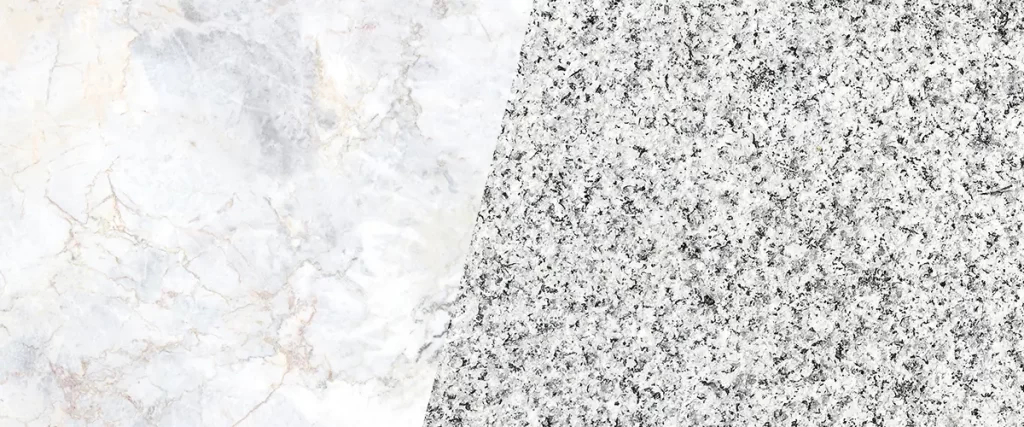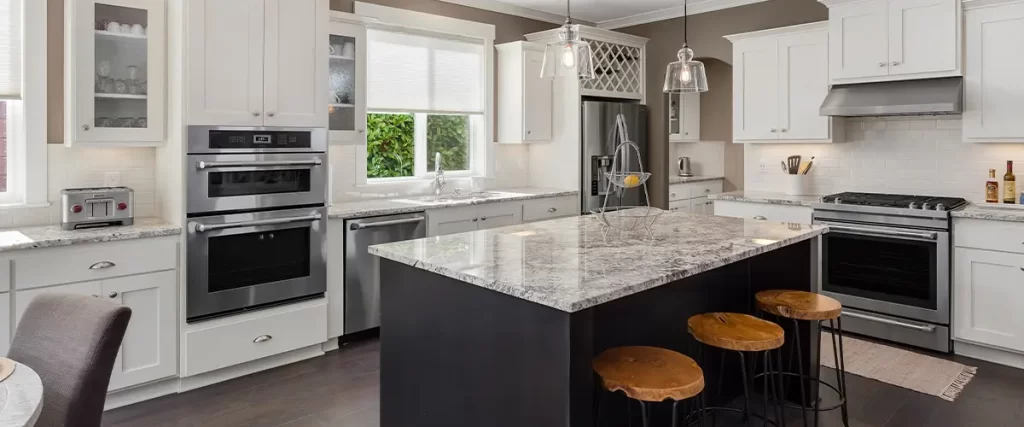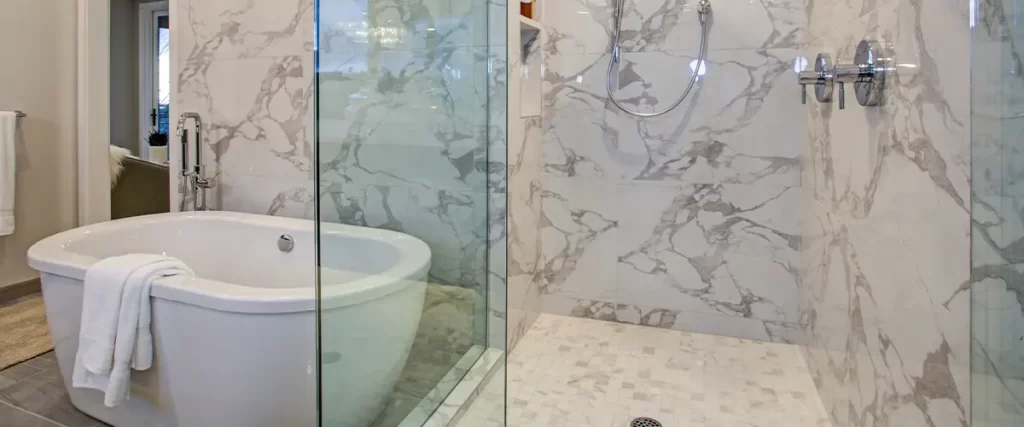When it comes to choosing the perfect stone for your kitchen countertops, bathroom vanities, or flooring, granite and marble are two of the most popular options. Both of these natural stones are beautiful and luxurious, but they each have distinct qualities that make them more or less suitable for different uses.
Whether you’re remodeling your kitchen or building a new home, understanding the differences between granite and marble can help you make an informed decision about which stone is right for your space.
In this article, we’ll compare granite and marble across several factors like durability, maintenance, cost, aesthetics, and functionality. Let’s dive in and explore the key differences between these two iconic stones.

What Is Granite?
Granite is an igneous rock formed from cooled magma, giving it a dense, durable, and non-porous structure. It is composed mostly of quartz, feldspar, and mica, making it one of the hardest natural stones available. Granite is often used for countertops, flooring, and even outdoor surfaces due to its strength and longevity.
Advantages of Granite:
Durability: Granite is incredibly durable and scratch-resistant. It can handle high temperatures, making it perfect for kitchen countertops where hot pots and pans are often used.
Low Maintenance: Once sealed properly, granite is resistant to stains and moisture. It doesn’t absorb liquids, making it easier to clean and maintain than other stones.
Variety of Styles: Granite is available in a wide range of colors, patterns, and finishes. Whether you prefer light, neutral tones or dark, dramatic hues, there’s a granite option to fit your style.
Long Lifespan: Granite is built to last and can maintain its integrity for decades, which is why it’s such a popular choice for high-traffic areas like kitchens and bathrooms.
Disadvantages of Granite:
Sealing Required: Although granite is naturally resistant to stains, it still requires periodic sealing to ensure that it maintains its non-porous properties.
Can Be Expensive: While granite is often less expensive than marble, it can still come with a high price tag, especially for premium varieties and intricate finishes.
Heavy: Granite is a dense, heavy stone, which means it can be more difficult to transport and install, requiring special consideration during installation.

What Is Marble?
Marble is a metamorphic rock formed from limestone under extreme heat and pressure. It is known for its luxurious appearance and is often used in high-end applications like kitchen countertops, bathroom vanities, and sculptures. Unlike granite, marble is a softer stone, which makes it more prone to scratches and damage over time.
Advantages of Marble:
Aesthetic Appeal: Marble is prized for its elegance and timeless beauty. It has a smooth, polished finish and is available in a range of colors, from classic white with veins to darker shades of green, black, or gray.
Unique Patterns: Each piece of marble is unique, with natural veining patterns that give it an artistic and sophisticated look.
Cool Surface: Marble naturally stays cooler than granite, which can be advantageous for certain tasks, such as baking, where a cool surface is ideal for working with dough.
Value: Due to its luxurious look, marble often increases the value of a home, making it a desirable option for those looking to add elegance and class to their property.
Disadvantages of Marble:
Prone to Scratching and Staining: Marble is a softer stone than granite, which means it’s more susceptible to scratching and staining from acidic substances like wine, lemon juice, and vinegar. It requires more careful maintenance.
High Maintenance: Marble requires regular sealing to maintain its beauty and prevent stains. It is more porous than granite, making it more susceptible to absorbing liquids and oils.
Expensive: Marble is often more expensive than granite, especially when you choose premium colors and finishes. It’s typically considered a luxury material due to its high-end appearance.
Can Yellow Over Time: Marble can develop a yellowish tint over time, particularly in high-traffic areas that are exposed to regular cleaning products or sunlight.

Key Differences Between Granite and Marble
1. Durability
- Granite: Extremely durable, resistant to scratches, and can handle high temperatures. It’s a tough stone that can withstand the daily wear and tear of busy kitchens.
- Marble: Softer and more porous than granite, making it more prone to scratches, stains, and etching from acidic substances. It requires more care, especially in kitchen settings.
2. Maintenance
- Granite: Requires minimal maintenance. Once sealed, it is resistant to stains, moisture, and heat, requiring only occasional cleaning with soap and water.
- Marble: Requires more frequent maintenance, including regular sealing and cleaning with pH-neutral products to avoid damage. It is more vulnerable to staining and scratching.
3. Aesthetics
- Granite: Available in a wide range of colors, patterns, and finishes, granite offers a more natural stone look, often with speckles and veins that are unique to each piece.
- Marble: Known for its luxurious look with natural veining and a smooth, polished surface. Marble has a classic, timeless beauty, often with striking patterns that make it a focal point in any room.
4. Cost
- Granite: Typically less expensive than marble, with costs varying depending on the type of granite and installation complexity. However, high-end granite can still be costly.
- Marble: Often more expensive than granite, particularly when it comes to premium or rare colors and finishes. It is considered a luxury material.
5. Heat Resistance
- Granite: Highly resistant to heat, making it ideal for kitchen countertops where hot cookware might be placed.
- Marble: More prone to heat damage, as excessive heat can cause discoloration or even cracks over time.
Best Uses for Granite and Marble
Granite:
- Kitchens: Ideal for countertops, backsplashes, and islands due to its heat and scratch resistance.
- Outdoor Spaces: Granite is an excellent choice for outdoor kitchens or patios due to its ability to withstand the elements and resist fading.
Marble:
- Bathrooms: Perfect for bathroom countertops, vanities, and even shower surrounds. Marble’s cool, polished surface makes it ideal for spaces where elegance and luxury are key.
- Feature Walls and Flooring: Its unique patterns make marble an excellent choice for feature walls or flooring in high-end homes.
Best Manufacturers for Granite and Marble
When choosing granite or marble, it’s important to work with reputable suppliers who offer high-quality stones. Here are some top manufacturers:
Best Manufacturers for Granite
- MSI Surfaces: MSI offers a wide range of high-quality granite slabs and tiles in various colors and finishes for countertops, flooring, and backsplashes.
- Cambria: Cambria offers a selection of durable, premium granite surfaces with unique patterns and textures perfect for both traditional and modern kitchens.
- Granite Expo: Granite Expo specializes in custom granite countertops with a focus on durability and aesthetic appeal, offering a variety of stone options for all types of home projects.
Best Manufacturers for Marble
- Polycor Polycor offers premium marble options, including various colors and veining patterns, for both residential and commercial projects.
- Thassos Marble Thassos Marble is known for its luxurious white marble slabs, which are perfect for creating timeless, elegant spaces in homes and businesses.
- Marble of the World A leading supplier of fine marble, Marble of the World offers a variety of styles, including classic and modern finishes, for high-end residential projects.
Frequently Asked Questions – Granite vs Marble
What’s the main difference between granite and marble?
The main difference lies in how these two natural stones are formed. Granite is an igneous rock that forms from molten magma deep in the earth’s crust, making it highly durable and heat resistant. Marble, on the other hand, is a metamorphic rock created when limestone undergoes intense heat and pressure, giving it a softer and more porous structure.
Granite is usually better for high-traffic areas like kitchen countertops because it’s scratch-resistant and requires less maintenance, while marble offers timeless elegance, often favored for bathroom vanities and feature walls.
Are granite countertops better than marble countertops?
It depends on how you plan to use them. Granite countertops are highly durable, stain-resistant, and perfect for kitchens where hot pans, acidic liquids like lemon juice, and regular knife use can occur.
Marble countertops, while not as scratch-resistant, bring a timeless beauty and are ideal for spaces that emphasize style, such as bathrooms or less busy kitchen counters. Both materials have unique characteristics, so the choice depends on your needs and design preference.
Do I need to seal granite or marble countertops?
Yes, both granite and marble surfaces will benefit from regular sealing to maintain their appearance and prevent stains. Because marble is a more porous material, it requires more frequent sealing compared to granite.
Sealing granite countertops is usually less maintenance-intensive and only needs to be done periodically, depending on the specific type of stone and its usage.
Can I put hot pots directly on granite or marble countertops?
Granite can handle hot pots and pans directly due to its heat-resistant nature. It’s one of the reasons why granite surfaces are ideal for kitchens. Marble, while heat-resistant to some extent, is more sensitive to high temperatures and is better protected if you use trivets or heat pads to avoid damaging the surface.
Which material is more stain-resistant, granite or marble?
Granite is more stain-resistant than marble because it’s less porous and more durable overall. Marble can stain easily if acidic liquids like lemon juice or wine are left on its surface for too long. Regular sealing can help both materials stay protected, but granite generally requires less maintenance in this regard.
Are marble tiles a good choice for flooring?
Marble tiles are an excellent choice for flooring in areas where timeless elegance is the goal, such as living rooms or bathrooms. However, because marble is a porous stone, you need to be careful in high-traffic areas since it can scratch or stain if not properly cared for.
Granite flooring, on the other hand, offers more durability and fewer maintenance concerns, making it better suited for busier spaces.
How do I clean granite and marble countertops?
Both granite and marble surfaces should be cleaned with a soft cloth and mild dish soap mixed with water. Avoid acidic or abrasive cleaners, as they can damage the stone over time. For stains, use a poultice designed specifically for natural stone. Regular maintenance can help these materials retain their natural beauty for a long period.
Which material is better for kitchens with white cabinets?
Both granite and marble pair beautifully with white cabinets. White marble can create a stunning, classic look with its timeless beauty, while natural granite, available in a variety of colors and patterns, offers high durability and easier maintenance for kitchens. Granite is often the more practical choice due to its scratch resistance and ability to handle high traffic and heat.

Conclusion
Both granite and marble are beautiful, durable stones that can elevate the design of any space. If you’re looking for a highly durable, low-maintenance surface that can withstand heat and wear, granite is the way to go. Choosing the best kitchen remodeling materials is essential for success.
However, if you want a luxurious, timeless aesthetic and are willing to invest in maintenance, marble offers a unique beauty that can enhance your home’s value.
Our team has been providing expert granite and marble services for years. Work with the best to ensure exceptional results and long-term savings. Contact us at (254) 369-5978 to start today!
